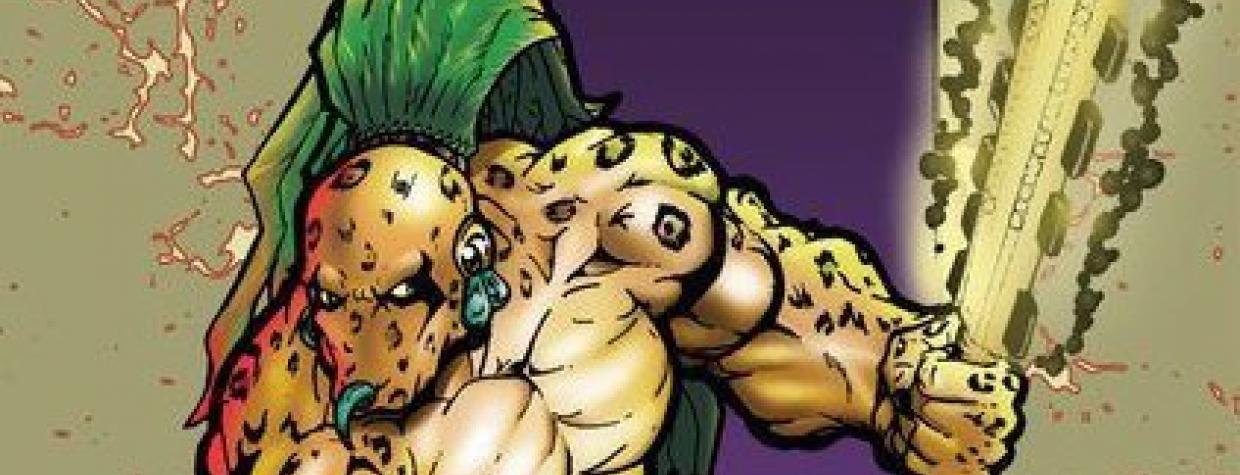Think X-Men, but with a Native American twist. That’s essentially what Tucson native Jon Proudstar has created with his comic-book series Tribal Force. Originally released in 1996, Proudstar’s comic was met with success and popularity, but after some setbacks and refusal to water down the content for publishers, it was set on the back burner. Now, Proudstar is working to bring Thunder Eagle, Earth, Little Bighorn, Adee, Jaguar Knight, Thunder Wolf and Kricket back for at least five more issues. We talked with Proudstar about the history and future of Tribal Force.
 What was the inspiration for Tribal Force?
What was the inspiration for Tribal Force?
I was always into comic books as a child, and I had always noticed there were no Native American superheroes. When they did come out, they were stereotypical and they never talked about that individual's tribe. For years I kind of joked around about, like, what would happen if Superman’s rocket landed on a reservation or if these superheroes were Latino or Native American ... how different would it have been? And then all of a sudden, in my mind, they formulated differently and I thought that would be kind of cool, if we could see heroes like that, that had more of an ethnic quality to them.
How did it impact you to not have relatable superheroes?
To not have these heroes to relate to is sort of the most difficult thing. As a child, when you’re Native or Latino, most of your heroes have been branded outlaws. Pancho Villa, Geronimo, Chief Joseph — they’re considered enemies of the state, but they’re our heroes. That affects children; that affects the development of a child, of where they feel their place is in society.
You did a lot of research before writing Tribal Force; why is culture so important to the story?
I work with survivors of child molestation and violent youth offenders, and one thing that I noticed in our culture was that the young people didn’t know much about the culture, including myself. And I thought, wouldn’t it be neat if I could utilize Native American superheroes to teach kids about their culture? So I started to design these characters based on Native American stories because I wanted a bridge between Native youths and elders.
After the initial popularity, Tribal Force disappeared. What brought it back?
[A few years ago], the Smithsonian Institution had inducted us into the Native American pop-culture exhibit because a lot of the up-and-coming Native artists were using imagery from Tribal Force. It started to get a little more attention. It was really difficult, because publishers did approach me, but they felt very strongly about the subject matter, because one of my characters is a survivor of childhood molestation, and from time to time I would write about those stories or those things that are pertinent to Native life.
Why was it so important to you to keep the difficult subject matter?
Seven out of 10 Native American girls experience a form of molestation or domestic violence in their lifetime. I wanted to create a character that these girls can relate to. And it was really important to me that I had a character that was born with fetal alcohol syndrome. And the publishers I was dealing with were like, "Well, these subjects, they’re really heavy." And I said, "Well, yeah; imagine having to live with that."
What difficulties have you run into trying to create new issues?
I tried to do a Kickstarter to raise $25,000, because that’s what it would take to put up a website and do five more issues. And I was going to do some free Internet content, because a lot of Native kids can’t afford comics. Unfortunately, we didn’t make our mark, and with Kickstarter, if you don’t make your goal you don’t get anything. It was really time-consuming, and having a full-time job at the time and trying to run a Kickstarter was like having two full-time jobs. Finally I just hit that point where I was like, "You know what, I’m just going to do it. I’ll draw it on my own. I’ll ink it on my own. I’ll save up my pennies to pay the colorist. And I’ll save up my pennies to pay each person as we go along and just do it piecemeal until the next issue."
What are your future hopes for Tribal Force?
My hope is that I can get Tribal Force back out there so that people can start reading and asking questions and doing the research on their own on these topics. If I can expose the numbers with Tribal Force and force the nation to deal with this, that’s my dream.
For more information about Tribal Force or to contact Proudstar, visit the Tribal Force Facebook page.
— Kirsten Kraklio

